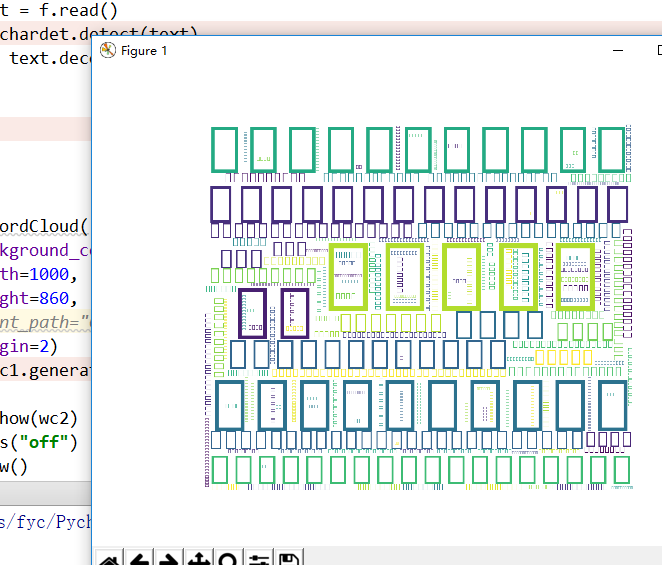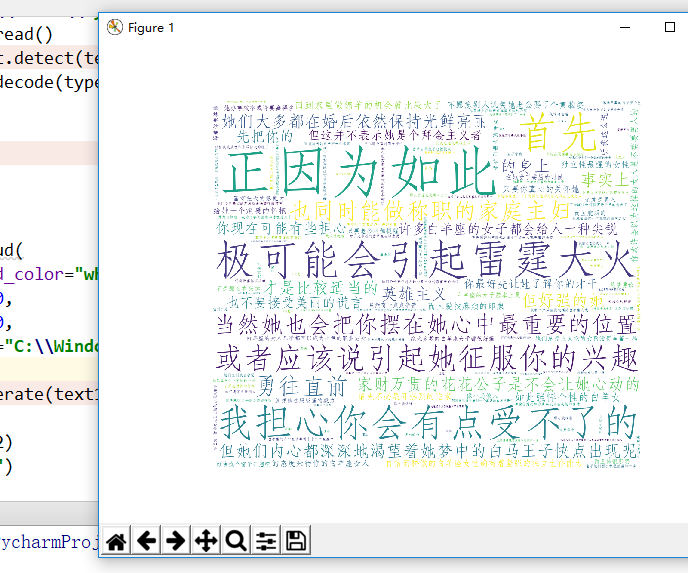詞雲wordcloud類介紹&python制作詞雲圖&詞雲圖亂碼問題等小坑
詞雲圖,大家一定見過,大數據時代大家經常見,我們今天就來用python的第三方庫wordcloud,來制作一個大數據詞雲圖,同時會降到這個過程中遇到的各種坑,
舉個例子,下面是我從自己的微信上抓的微信好友簽名,制作的詞雲圖:看來用的做多的還是“方得始終”啊

首先我們需要幾個庫,pip完了導入
1 import chardet #檢測字符類型的類 2 from wordcloud import WordCloud #詞雲庫 3 import matplotlib.pyplot as plt #數學繪圖庫
咱們這個例子分2步,第一步:從文件讀取一段文字,第二步制作詞雲圖並顯示出來
看代碼:從桌面讀取一個文件
1 with open("C:\\Users\\fyc\\Desktop\\virgo.txt", "r") as f: 2 text = f.read() 3 type = chardet.detect(text) 4 text1 = text.decode(type["encoding"])
在這要做一個編碼的工作,應為詞雲的generate函數接受的是一個Unicode類的對象,其他的對象會導致異常,經過層層跟進,終於在wordcloud.py文件裏發現了這一行代碼:
1 stopwords = set(map(str.lower, self.stopwords))2 3 flags = (re.UNICODE if sys.version < ‘3‘ and type(text) is unicode 4 else 0) 5 regexp = self.regexp if self.regexp is not None else r"\w[\w‘]+" 6 7 words = re.findall(regexp, text, flags)
問題出在正則表達式:如果不是unicode類型,進來的text經過re.findall計算,將什麽也匹配不到,words為一個空list,隨後就會拋出異常
所以在generate()之前一定要轉碼成“Unicode”類型。
第二步:生成詞雲,並顯示:
1 wc1 = WordCloud( 2 background_color="white", 3 width=1000, 4 height=860, 5 font_path="C:\\Windows\\Fonts\\STFANGSO.ttf",#不加這一句顯示口字形亂碼 6 margin=2) 7 wc2 = wc1.generate(text1) #我們觀察到generate()接受一個Unicode的對象,所以之前要把文本處理成unicode類型 8 9 plt.imshow(wc2) 10 plt.axis("off") 11 plt.show()
wordcloud構造處一個詞雲對象,然後generate()方法把傳進來的文本“text"按照詞出現的頻率安排詞的大小,其中text,我是找了一篇關於白羊座的介紹,文字如下:
豪放率真的白羊座女生,富有強大的想象力,熱情勇敢,女漢子味十足。勇往直前,是你們最大的特點。所以即便面對困難挫折,白羊女都敢於迎接挑戰。可以說,這是個極具戰鬥精神的新時代女性。如此強悍個性的白羊女,在異性的眼中卻永遠都少了點女人味專屬的溫柔,往往都是稱兄道弟的份。
如果你期待一個林黛玉般的女孩來滿足你的男子氣概,碰到了她,你可真是門兒都沒有了,識相的話,趕快找個窗子開溜吧!在火星守護下的白羊座女子,通常是積極而且堅強的。像小鳥依人、楚楚可憐這一類的形容詞很難加諸在她身上。
白羊座的女子應該算得上十二個星座中,獨立性最強的女性。她絕對不是那種整天守在家裏,等著你來接她、送她,完全缺乏獨立行動能力的典型。對於大多數的白羊座女孩來說,她寧願相信如果沒有你在身邊礙手礙腳,她辦事效率或許要高得多。聽我這麽說,你或許會以為這樣的女人是不需要男人的!那可就錯啦!自信而驕傲的白羊座女性確有著堅強的獨立生存能力。但她們內心都深深地渴望著她夢中的白馬王子快點出現呢!很難相信吧!看起來那麽銳利的她,其實是充滿著童話般夢想的。而對所有的白羊座女子來說,她們心裏最大的矛盾就是渴望征服對方,又期待著被對方征服的微妙心裏。
你現在可能有些擔心,不知道該如何扮演好自已的角色了,是嗎?別慌!先把你的“真心”準備好,以後的辦法就好商量了,雖然有一點點辛苦,不過保證值得。
首先,你必須認清,白羊座的女子基本上是“英雄主義”的。她會傾心於一個令她佩服的男人。她要嫁一個讓她引以為傲的丈夫。她或許會比較欣賞事業有成的男人,但這並不表示她是個拜金主義者。家財萬貫的花花公子是不會讓她心動的,滿腔理想的熱血青年反而會受她的青睞。因此,如果你愛上了一個白羊座的女子,請先不必展開熱烈的追求。哈巴狗一樣的男人會讓她既討厭又害怕,她深怕給你一個禮貌的微笑之後,你就會死纏著她不放了。你最好先讓她了解你的才幹、你的魅力,引起她對你的好奇(或者應該說引起她征服你的興趣),等你感受到她對你真有好感之後,你再誠懇的對她表示愛意,那麽前途就大有可為了!
你要像個“大男人”的樣子(我說過她很英雄主義),但是你絕不能對她頤指氣使。你一定要真心的關懷她,但絕對不要太縱容她。我想你應該用一種“英雄惜英雄”的態度來待你的白羊座女人,才是比較適當的。
絕大多數的白羊座女子都很好強,她們堅持要在對方的心目中保持最重要的地位。當然她也會把你擺在她心中最重要的位置。而且她很忠實、很大方。她願意與你分享她的一切。當然,她也會認為你應該與她分享一切,包括你的秘密。欺騙你的白羊座女人,有如犯了欺君之罪一樣的嚴重。這一點你可千萬要記住,她情願聽你令她心碎的懺悔,也不要接受美麗的謊言。你最好少在她面前誇獎其她的女孩,尤其是那種由衷的贊美,極可能會引起雷霆大火。
由於她們那麽積極堅強的個性,許多白羊座的女子都會給人一種尖銳、而且愛找麻煩的印象。在表面上,她們是不會讓別人(尤其是男人)占便宜的。很多人會認為白羊座的女人總是尖嘴利牙的得理不饒人。正因為如此,她們常常會吃些暗虧,受到挫折,她們總是比其它的女孩活得辛苦一些。其實,你應該明白,她們的內心多半是正直、善良,而且脆弱的。只要你真心的關懷她,在她受了委屈的時侯,給她一個溫暖的懷抱,她會成為你一生忠實可靠的伴侶。
白羊座的女人幾乎都可以成為出色的職業婦女,也同時能做稱職的家庭主婦。事實上,讓她擁有自已的事業對你們的婚姻是有幫助的。當她盡量在工作上發揮了她的好勝心和征服欲之後,回到家裏做綿羊的機會就比較大了。如果要一個精力旺盛的白羊座女子,把心思全放在“你”的身上,我擔心你會有點受不了的。至於家庭,你大可放心,她雖然柴米油鹽之類的瑣事,不是那麽有興趣,但好強的她,不會讓自已成為一個失敗的主婦的。
還有件事你該慶幸,那就是我很少看到一個邋遢的白羊座妻子,她們大多都在婚後依然保持光鮮亮麗,不願意別人譏笑她老公娶了個黃臉婆。就算偶爾懶散一下,只要老公稍加提醒,她們立刻就會警覺。我有個產後稍微發福的白羊座女友,就因為老公說了一句“以前我最欣賞你那雙修長的腿了。”她硬是兩個月減肥了二十磅。就憑她這股堅強的毅力,你能不相信她會全力以赴的做個好妻子嗎?
關於構造方法的介紹需要說明幾點:第一,用的是關鍵詞參數,無需記住參數位置,技術參數的關鍵詞就行。
關於參數的含義,在pycharm中查看快速文檔,說明如下:
class WordCloud(object) def __init__(self, font_path=None, width=400, height=200, margin=2, ranks_only=None, prefer_horizontal=.9, mask=None, scale=1, color_func=None, max_words=200, min_font_size=4, stopwords=None, random_state=None, background_color=‘black‘, max_font_size=None, font_step=1, mode="RGB", relative_scaling=.5, regexp=None, collocations=True, colormap=None, normalize_plurals=True) Documentation is missing. The following is copied from class WordCloud. Word cloud object for generating and drawing. font_path: (string) Font path to the font that will be used (OTF or TTF). Defaults to DroidSansMono path on a Linux machine. If you are on another OS or don‘t have this font, you need to adjust this path. width: (int (default=400)) Width of the canvas. height: (int (default=200)) Height of the canvas. prefer_horizontal: (float (default=0.90)) The ratio of times to try horizontal fitting as opposed to vertical. If prefer_horizontal < 1, the algorithm will try rotating the word if it doesn‘t fit. (There is currently no built-in way to get only vertical words.) mask: (nd-array or None (default=None)) If not None, gives a binary mask on where to draw words. If mask is not None, width and height will be ignored and the shape of mask will be used instead. All white (#FF or #FFFFFF) entries will be considerd "masked out" while other entries will be free to draw on. [This changed in the most recent version!] scale: (float (default=1)) Scaling between computation and drawing. For large word-cloud images, using scale instead of larger canvas size is significantly faster, but might lead to a coarser fit for the words. min_font_size: (int (default=4)) Smallest font size to use. Will stop when there is no more room in this size. font_step: (int (default=1)) Step size for the font. font_step > 1 might speed up computation but give a worse fit. max_words: (number (default=200)) The maximum number of words. stopwords: (set of strings or None) The words that will be eliminated. If None, the build-in STOPWORDS list will be used. background_color: (color value (default="black")) Background color for the word cloud image. max_font_size: (int or None (default=None)) Maximum font size for the largest word. If None, height of the image is used. mode: (string (default="RGB")) Transparent background will be generated when mode is "RGBA" and background_color is None. relative_scaling: (float (default=.5)) Importance of relative word frequencies for font-size. With relative_scaling=0, only word-ranks are considered. With relative_scaling=1, a word that is twice as frequent will have twice the size. If you want to consider the word frequencies and not only their rank, relative_scaling around .5 often looks good. color_func: (callable, default=None) Callable with parameters word, font_size, position, orientation, font_path, random_state that returns a PIL color for each word. Overwrites "colormap". See colormap for specifying a matplotlib colormap instead. regexp: (string or None (optional)) Regular expression to split the input text into tokens in process_text. If None is specified, r"\w[\w‘]+" is used. collocations: (bool, default=True) Whether to include collocations (bigrams) of two words. colormap: (string or matplotlib colormap, default="viridis") Matplotlib colormap to randomly draw colors from for each word. Ignored if "color_func" is specified. normalize_plurals: (bool, default=True) Whether to remove trailing ‘s‘ from words. If True and a word appears with and without a trailing ‘s‘, the one with trailing ‘s‘ is removed and its counts are added to the version without trailing ‘s‘ – unless the word ends with ‘ss‘. Notes Larger canvases with make the code significantly slower. If you need a large word cloud, try a lower canvas size, and set the scale parameter. The algorithm might give more weight to the ranking of the words than their actual frequencies, depending on the max_font_size and the scaling heuristic.
大家使用百度翻譯應該能看明白,這裏說明幾個比較關鍵的參數:
font_path:這個是在詞雲圖中顯示文字的字體存放的路徑,特別是在顯示中文的時候,這個參數尤為重要,如果缺省的話容易造成亂碼,如下:

width,height 顧名思義,畫布的長寬。
prefer_horizontal :詞雲的字體優先水平放置
mask:這是背景的形狀,缺省是畫布的形狀。
其他幾個參數就不說了
第三步就是用matplotlib庫將詞雲圖顯示出來,這一段代碼比較固定,沒什麽變化,死記硬背了
1 plt.imshow(wc2) 2 plt.axis("off") 3 plt.show()
其中,axis是顯示坐標,這裏我們選擇不現實坐標。整體效果如下:
詞雲wordcloud類介紹&python制作詞雲圖&詞雲圖亂碼問題等小坑
